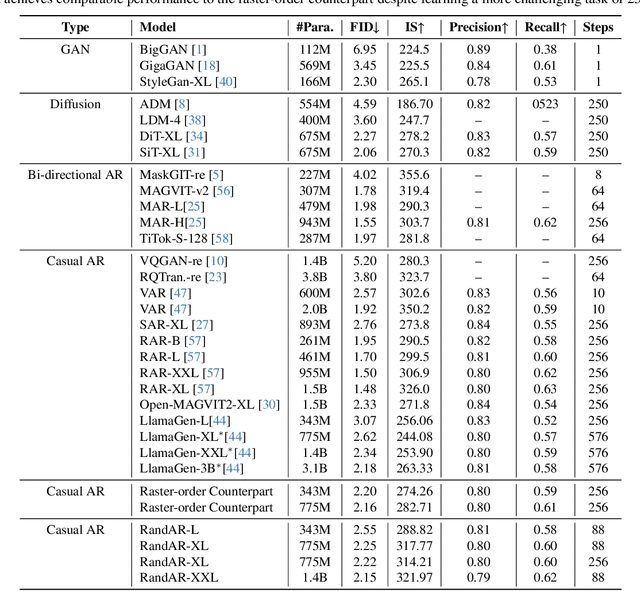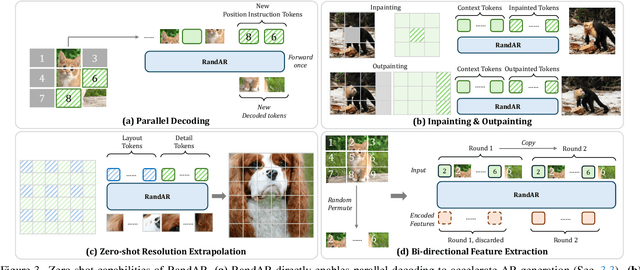Tianyuan Zhang
Adversarial Generation and Collaborative Evolution of Safety-Critical Scenarios for Autonomous Vehicles
Aug 20, 2025Abstract:The generation of safety-critical scenarios in simulation has become increasingly crucial for safety evaluation in autonomous vehicles prior to road deployment in society. However, current approaches largely rely on predefined threat patterns or rule-based strategies, which limit their ability to expose diverse and unforeseen failure modes. To overcome these, we propose ScenGE, a framework that can generate plentiful safety-critical scenarios by reasoning novel adversarial cases and then amplifying them with complex traffic flows. Given a simple prompt of a benign scene, it first performs Meta-Scenario Generation, where a large language model, grounded in structured driving knowledge, infers an adversarial agent whose behavior poses a threat that is both plausible and deliberately challenging. This meta-scenario is then specified in executable code for precise in-simulator control. Subsequently, Complex Scenario Evolution uses background vehicles to amplify the core threat introduced by Meta-Scenario. It builds an adversarial collaborator graph to identify key agent trajectories for optimization. These perturbations are designed to simultaneously reduce the ego vehicle's maneuvering space and create critical occlusions. Extensive experiments conducted on multiple reinforcement learning based AV models show that ScenGE uncovers more severe collision cases (+31.96%) on average than SoTA baselines. Additionally, our ScenGE can be applied to large model based AV systems and deployed on different simulators; we further observe that adversarial training on our scenarios improves the model robustness. Finally, we validate our framework through real-world vehicle tests and human evaluation, confirming that the generated scenarios are both plausible and critical. We hope our paper can build up a critical step towards building public trust and ensuring their safe deployment.
Pushing the Limits of Safety: A Technical Report on the ATLAS Challenge 2025
Jun 14, 2025Abstract:Multimodal Large Language Models (MLLMs) have enabled transformative advancements across diverse applications but remain susceptible to safety threats, especially jailbreak attacks that induce harmful outputs. To systematically evaluate and improve their safety, we organized the Adversarial Testing & Large-model Alignment Safety Grand Challenge (ATLAS) 2025}. This technical report presents findings from the competition, which involved 86 teams testing MLLM vulnerabilities via adversarial image-text attacks in two phases: white-box and black-box evaluations. The competition results highlight ongoing challenges in securing MLLMs and provide valuable guidance for developing stronger defense mechanisms. The challenge establishes new benchmarks for MLLM safety evaluation and lays groundwork for advancing safer multimodal AI systems. The code and data for this challenge are openly available at https://github.com/NY1024/ATLAS_Challenge_2025.
Test-Time Training Done Right
May 29, 2025Abstract:Test-Time Training (TTT) models context dependencies by adapting part of the model's weights (referred to as fast weights) during inference. This fast weight, akin to recurrent states in RNNs, stores temporary memories of past tokens in the current sequence. Existing TTT methods struggled to show effectiveness in handling long-context data, due to their inefficiency on modern GPUs. The TTT layers in many of these approaches operate with extremely low FLOPs utilization (often <5%) because they deliberately apply small online minibatch sizes (e.g., updating fast weights every 16 or 64 tokens). Moreover, a small minibatch implies fine-grained block-wise causal dependencies in the data, unsuitable for data beyond 1D ordered sequences, like sets or N-dimensional grids such as images or videos. In contrast, we pursue the opposite direction by using an extremely large chunk update, ranging from 2K to 1M tokens across tasks of varying modalities, which we refer to as Large Chunk Test-Time Training (LaCT). It improves hardware utilization by orders of magnitude, and more importantly, facilitates scaling of nonlinear state size (up to 40% of model parameters), hence substantially improving state capacity, all without requiring cumbersome and error-prone kernel implementations. It also allows easy integration of sophisticated optimizers, e.g. Muon for online updates. We validate our approach across diverse modalities and tasks, including novel view synthesis with image set, language models, and auto-regressive video diffusion. Our approach can scale up to 14B-parameter AR video diffusion model on sequences up to 56K tokens. In our longest sequence experiment, we perform novel view synthesis with 1 million context length. We hope this work will inspire and accelerate new research in the field of long-context modeling and test-time training. Website: https://tianyuanzhang.com/projects/ttt-done-right
Manipulating Multimodal Agents via Cross-Modal Prompt Injection
Apr 22, 2025Abstract:The emergence of multimodal large language models has redefined the agent paradigm by integrating language and vision modalities with external data sources, enabling agents to better interpret human instructions and execute increasingly complex tasks. However, in this work, we identify a critical yet previously overlooked security vulnerability in multimodal agents: cross-modal prompt injection attacks. To exploit this vulnerability, we propose CrossInject, a novel attack framework in which attackers embed adversarial perturbations across multiple modalities to align with target malicious content, allowing external instructions to hijack the agent's decision-making process and execute unauthorized tasks. Our approach consists of two key components. First, we introduce Visual Latent Alignment, where we optimize adversarial features to the malicious instructions in the visual embedding space based on a text-to-image generative model, ensuring that adversarial images subtly encode cues for malicious task execution. Subsequently, we present Textual Guidance Enhancement, where a large language model is leveraged to infer the black-box defensive system prompt through adversarial meta prompting and generate an malicious textual command that steers the agent's output toward better compliance with attackers' requests. Extensive experiments demonstrate that our method outperforms existing injection attacks, achieving at least a +26.4% increase in attack success rates across diverse tasks. Furthermore, we validate our attack's effectiveness in real-world multimodal autonomous agents, highlighting its potential implications for safety-critical applications.
REG: Rectified Gradient Guidance for Conditional Diffusion Models
Jan 31, 2025Abstract:Guidance techniques are simple yet effective for improving conditional generation in diffusion models. Albeit their empirical success, the practical implementation of guidance diverges significantly from its theoretical motivation. In this paper, we reconcile this discrepancy by replacing the scaled marginal distribution target, which we prove theoretically invalid, with a valid scaled joint distribution objective. Additionally, we show that the established guidance implementations are approximations to the intractable optimal solution under no future foresight constraint. Building on these theoretical insights, we propose rectified gradient guidance (REG), a versatile enhancement designed to boost the performance of existing guidance methods. Experiments on 1D and 2D demonstrate that REG provides a better approximation to the optimal solution than prior guidance techniques, validating the proposed theoretical framework. Extensive experiments on class-conditional ImageNet and text-to-image generation tasks show that incorporating REG consistently improves FID and Inception/CLIP scores across various settings compared to its absence.
RandAR: Decoder-only Autoregressive Visual Generation in Random Orders
Dec 02, 2024



Abstract:We introduce RandAR, a decoder-only visual autoregressive (AR) model capable of generating images in arbitrary token orders. Unlike previous decoder-only AR models that rely on a predefined generation order, RandAR removes this inductive bias, unlocking new capabilities in decoder-only generation. Our essential design enables random order by inserting a "position instruction token" before each image token to be predicted, representing the spatial location of the next image token. Trained on randomly permuted token sequences -- a more challenging task than fixed-order generation, RandAR achieves comparable performance to its conventional raster-order counterpart. More importantly, decoder-only transformers trained from random orders acquire new capabilities. For the efficiency bottleneck of AR models, RandAR adopts parallel decoding with KV-Cache at inference time, enjoying 2.5x acceleration without sacrificing generation quality. Additionally, RandAR supports inpainting, outpainting and resolution extrapolation in a zero-shot manner. We hope RandAR inspires new directions for decoder-only visual generation models and broadens their applications across diverse scenarios. Our project page is at https://rand-ar.github.io/.
Visual Adversarial Attack on Vision-Language Models for Autonomous Driving
Nov 27, 2024



Abstract:Vision-language models (VLMs) have significantly advanced autonomous driving (AD) by enhancing reasoning capabilities. However, these models remain highly vulnerable to adversarial attacks. While existing research has primarily focused on general VLM attacks, the development of attacks tailored to the safety-critical AD context has been largely overlooked. In this paper, we take the first step toward designing adversarial attacks specifically targeting VLMs in AD, exposing the substantial risks these attacks pose within this critical domain. We identify two unique challenges for effective adversarial attacks on AD VLMs: the variability of textual instructions and the time-series nature of visual scenarios. To this end, we propose ADvLM, the first visual adversarial attack framework specifically designed for VLMs in AD. Our framework introduces Semantic-Invariant Induction, which uses a large language model to create a diverse prompt library of textual instructions with consistent semantic content, guided by semantic entropy. Building on this, we introduce Scenario-Associated Enhancement, an approach where attention mechanisms select key frames and perspectives within driving scenarios to optimize adversarial perturbations that generalize across the entire scenario. Extensive experiments on several AD VLMs over multiple benchmarks show that ADvLM achieves state-of-the-art attack effectiveness. Moreover, real-world attack studies further validate its applicability and potential in practice.
Buffer Anytime: Zero-Shot Video Depth and Normal from Image Priors
Nov 26, 2024Abstract:We present Buffer Anytime, a framework for estimation of depth and normal maps (which we call geometric buffers) from video that eliminates the need for paired video--depth and video--normal training data. Instead of relying on large-scale annotated video datasets, we demonstrate high-quality video buffer estimation by leveraging single-image priors with temporal consistency constraints. Our zero-shot training strategy combines state-of-the-art image estimation models based on optical flow smoothness through a hybrid loss function, implemented via a lightweight temporal attention architecture. Applied to leading image models like Depth Anything V2 and Marigold-E2E-FT, our approach significantly improves temporal consistency while maintaining accuracy. Experiments show that our method not only outperforms image-based approaches but also achieves results comparable to state-of-the-art video models trained on large-scale paired video datasets, despite using no such paired video data.
LVSM: A Large View Synthesis Model with Minimal 3D Inductive Bias
Oct 22, 2024



Abstract:We propose the Large View Synthesis Model (LVSM), a novel transformer-based approach for scalable and generalizable novel view synthesis from sparse-view inputs. We introduce two architectures: (1) an encoder-decoder LVSM, which encodes input image tokens into a fixed number of 1D latent tokens, functioning as a fully learned scene representation, and decodes novel-view images from them; and (2) a decoder-only LVSM, which directly maps input images to novel-view outputs, completely eliminating intermediate scene representations. Both models bypass the 3D inductive biases used in previous methods -- from 3D representations (e.g., NeRF, 3DGS) to network designs (e.g., epipolar projections, plane sweeps) -- addressing novel view synthesis with a fully data-driven approach. While the encoder-decoder model offers faster inference due to its independent latent representation, the decoder-only LVSM achieves superior quality, scalability, and zero-shot generalization, outperforming previous state-of-the-art methods by 1.5 to 3.5 dB PSNR. Comprehensive evaluations across multiple datasets demonstrate that both LVSM variants achieve state-of-the-art novel view synthesis quality. Notably, our models surpass all previous methods even with reduced computational resources (1-2 GPUs). Please see our website for more details: https://haian-jin.github.io/projects/LVSM/ .
RelitLRM: Generative Relightable Radiance for Large Reconstruction Models
Oct 10, 2024



Abstract:We propose RelitLRM, a Large Reconstruction Model (LRM) for generating high-quality Gaussian splatting representations of 3D objects under novel illuminations from sparse (4-8) posed images captured under unknown static lighting. Unlike prior inverse rendering methods requiring dense captures and slow optimization, often causing artifacts like incorrect highlights or shadow baking, RelitLRM adopts a feed-forward transformer-based model with a novel combination of a geometry reconstructor and a relightable appearance generator based on diffusion. The model is trained end-to-end on synthetic multi-view renderings of objects under varying known illuminations. This architecture design enables to effectively decompose geometry and appearance, resolve the ambiguity between material and lighting, and capture the multi-modal distribution of shadows and specularity in the relit appearance. We show our sparse-view feed-forward RelitLRM offers competitive relighting results to state-of-the-art dense-view optimization-based baselines while being significantly faster. Our project page is available at: https://relit-lrm.github.io/.
 Add to Chrome
Add to Chrome Add to Firefox
Add to Firefox Add to Edge
Add to Edge